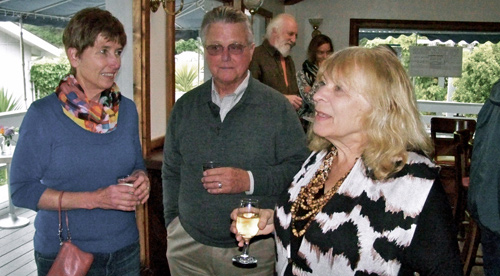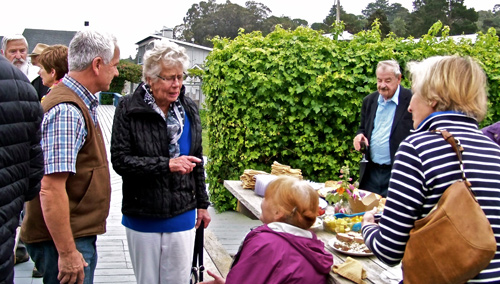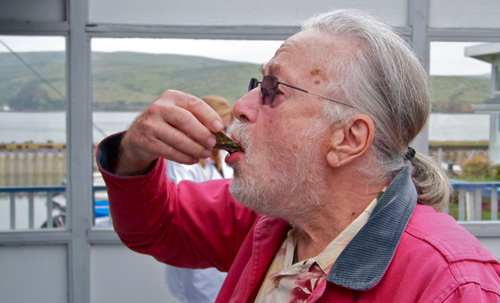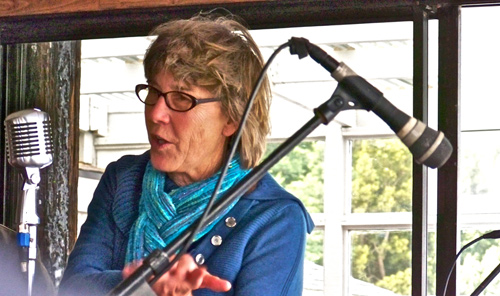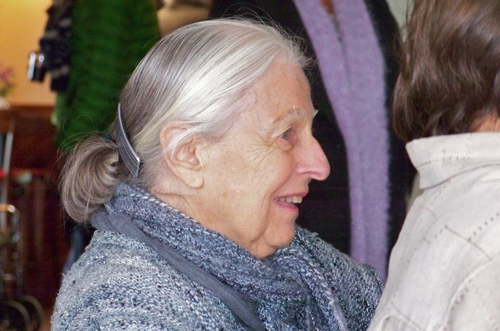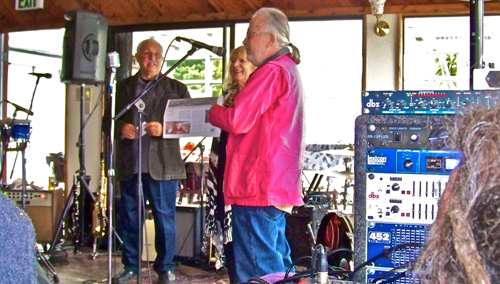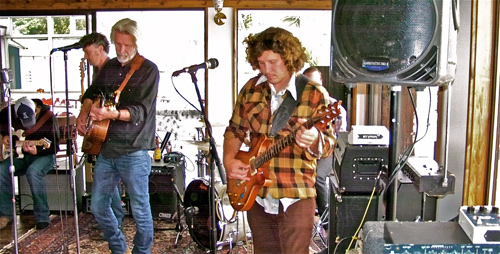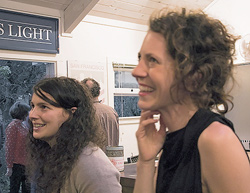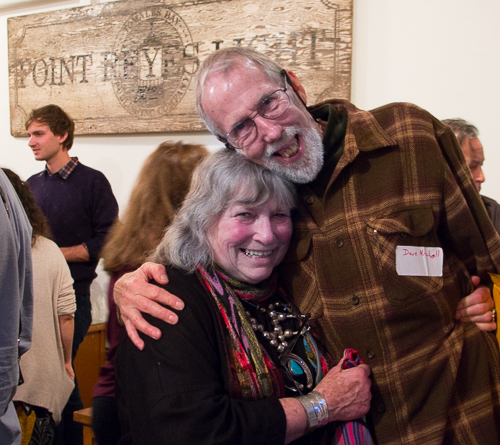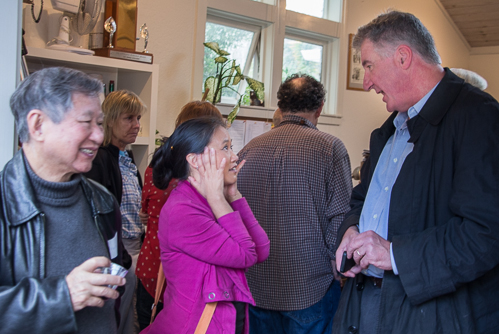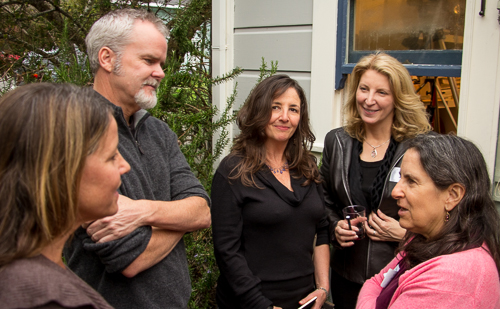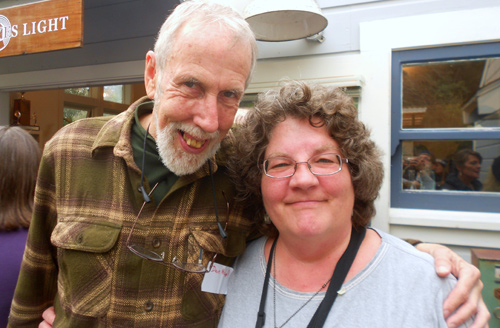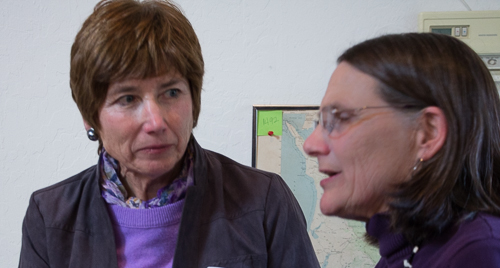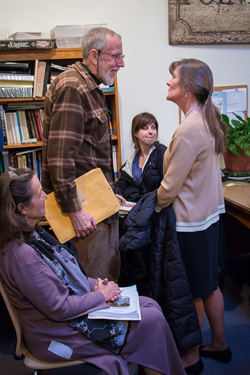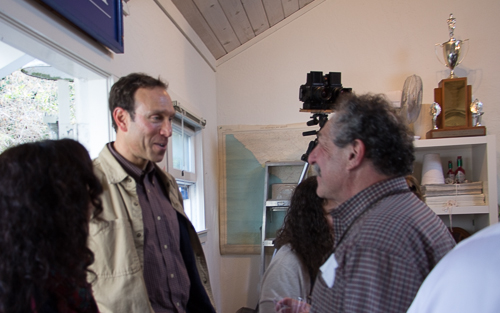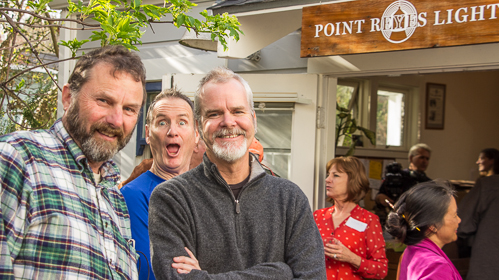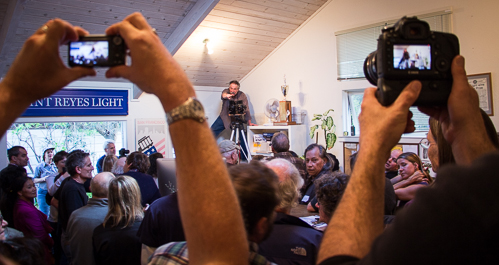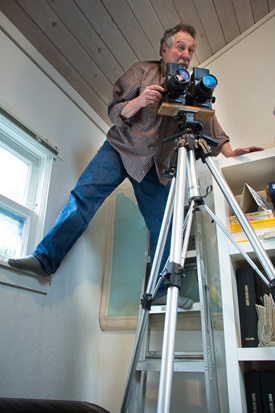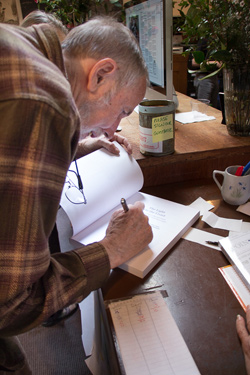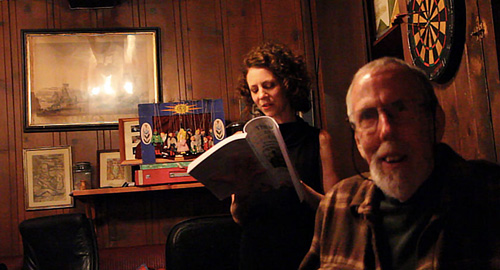Entries tagged with “Dewey Livingston”.
Did you find what you wanted?
Mon 4 May 2015
About 150 people showed up Sunday at Tomales Bay Resort and Marina for a Community Farewell to former West Marin Citizen publisher Linda Petersen of Inverness. Petersen on Saturday sold her paper to Point Reyes Light editor Tess Elliott and her partner David Briggs.
The Citizen will now cease publication, and The Light should be more financially sustainable as the only newspaper for a readership area of about 10,000 people.
As one speaker at the party noted, the creation of The Citizen in 2007 grew out of community resentment toward sensationalism in The Light while it was published by Robert Plotkin of Bolinas from 2005 to 2010. The advent of a competitor created financial problems for The Light, Plotkin acknowledged in 2010, but The Citizen itself wasn’t highly profitable.
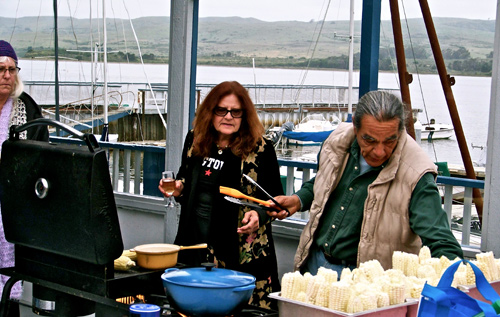
With Tomales Bay and the resort’s marina in the background, the artist Vickisa of Bolinas makes mental notes as corn cobs are barbecued on the deck of the resort.

The Citizen’s former obituary writer Larken Bradley (left) and her husband Mark chat with Linda Petersen, who will soon move to Portland to be near her son and daughter and their families.
Unable to attend the event was my partner Lynn Axelrod, who started The Citizen’s calendar section and who for three years was the paper’s only regular reporter. As a reporter, she often did the work of a news editor, finding many of the news stories she covered. In this role, she received compliments and thanks from readers.

Former oyster-grower Kevin Lunny (left), whose family plans to open an oyster bistro at the resort, chats with Ulla McLean of Point Reyes Station (center) and Joyce Goldfield of Inverness Park.

Joel Hack of Bodega Bay founded The West Marin Citizen in June 2007 under the name West Marin Pilot. When the paper began publishing weekly the following month, the name was changed to West Marin Citizen. Here Hack enjoys slurping down an oyster on the half shell.
 George Clyde of Marshall (left), a former programmer at KWMR radio, swaps stories with historian Dewey Livingston of Inverness.
George Clyde of Marshall (left), a former programmer at KWMR radio, swaps stories with historian Dewey Livingston of Inverness.

As Petersen prepares to move from Inverness to Portland, Bernie Stephan, the master of ceremonies, takes note of the many places she’s lived, including Denmark, Sweden, Hawaii, and Puerto Rico.

Kris Brown, who is active in progressive politics locally, tells of how much she enjoyed working with Petersen.

Stinson Beach gallery owner Claudia Chapline, who has been writing art reviews for The Citizen, has let it be known she will now write them for The Light.

Joel Hack, who founded The Citizen eight years ago, previously published The Bodega Bay Navigator. He turned The Citizen over to Petersen, who was then his ad manager, three and a half years ago.

The Haggards with Colin Schlitt, Van Van der Maaten, Danny Vitali (standing left to right) weren’t the only local performers well received by the audience. Performing later in the evening was the band El Radio Fantastique, who got everyone dancing — including small children and band member Loyal Tarbot’s 92-year-old grandmother.

As is common at community events hereabouts, Art Rogers of Point Reyes Station had the guests pose for group photo. Standing left of Petersen, who has just received a bouquet, is Tess Elliott, editor of The Light, and her partner David Briggs. Seated at far right is Mary Olsen who with Teri Mattson hosted the farewell party.
Tue 4 Mar 2014
During an open house and reunion Saturday, a happy throng of Point Reyes Light readers, staff, and columnists joined with former staff and correspondents to celebrate the 66th anniversary of the newspaper’s first issue. 
The reunion drew staff and contributors who had worked at the paper at different times during the past 44 years. A number of former staff traveled hundreds of miles to attend. A couple of them arrived from out of state.
From left: Laura Lee Miller, David Rolland (who drove up from San Diego), Cat Cowles, Wendi Kallins, Janine Warner (who drove up from Los Angeles), Elisabeth Ptak (back to camera), Gayanne Enquist, Art Rogers (talking with Elisabeth), Keith Ervin (who drove down from Seattle), B.G. Buttemiller, and (in blue shirt with back to camera) Victor Reyes. (Photo by Dave LaFontaine) ______________________________________________________________
 The party was also a celebration of the Tomales Regional History Center’s publishing The Light on the Coast: 65 Years of News Big and Small as Reported in The Point Reyes Light.
The party was also a celebration of the Tomales Regional History Center’s publishing The Light on the Coast: 65 Years of News Big and Small as Reported in The Point Reyes Light.
Stuart Chapman of Bolinas, a former member of the staff, shot this photo, which he titled “Dave, Proud Father” because I authored the book.
My co-author was Jacoba Charles. Jacoba reported for The Light under its previous ownership and is a member of the paper’s board of directors under its present ownership, Marin Media Institute.
The colored Post-its, by the way, mark selections that I, along with others, would be reading to attendees. ____________________________________________________________

From left: Co-author Jacoba Charles, photographer Art Rogers, scientist Corey Goodman, photographer David Briggs, editorial consultant on the book and former member of The Light’s ad department Lynn Axelrod, and Spanish-language columnist Victor Reyes. (Except where noted otherwise, the photos in this posting were shot by former Light reporter Janine Warner)

Michael Gahagan (left), who drove down from the Sierra Nevada town of Columbia to attend, published The Light from 1970 to 1975. Here he reminisces with historian Dewey Livingston of Inverness. Dewey for many years provided a weekly historical feature titled “West Marin’s Past.”

During the Gahagan years, Lee Sims (left) was the newspaper’s main typographer. This was back in the days before offset printing, and each page that went on the press had to be composed in lead.
In a piece written for The Light’s 30th anniversary in 1978 and reprinted in The Light on the Coast, Michael Gahagan’s former wife Annabelle comments, “Poor Lee, he had the disadvantage of being a friend of ours. One can always depend on friends, and we did lean on him! He was always underpaid and overworked. (Weren’t we all?)”

Catching up on old times are (in foreground from left): former news editor David Rolland, who drove to the reunion from San Diego, former typesetter Cat Cowles of Inverness, and former reporter Joel Reese, who flew in from Chicago. Standing behind them are current reporter Christopher Peak (left) and Matt Gallagher, who filled in as managing editor from February through July 2011. _____________________________________________________________
 Samantha Kimmey (on the left) has been a reporter at The Light for the past year. With her is Tess Elliott of Inverness, who has been The Light’s editor for the past eight year. ____________________________________________________________
Samantha Kimmey (on the left) has been a reporter at The Light for the past year. With her is Tess Elliott of Inverness, who has been The Light’s editor for the past eight year. ____________________________________________________________

Gayanne Enquist was office manager during much of the 27 years I owned The Light. She was there when I arrived in July 1975, and she was there when I left in November 2005. (I was away reporting for the old San Francisco Examiner between September 1981 and the end of 1983.)

Former reporter Michelle Ling trades stories with Don Schinske, who was business manager during the 1990s and was co-publisher from 1995 to 1998. At left is her father, Dr. Walter Ling who teaches at UCLA. With his wife, May, Dr. Ling drove to Point Reyes Station for the celebration. In the background, Mary Papale listens intently to Laura Rogers.

Ingrid Noyes of Marshall (left) tells a story to my co-author, Jacoba Charles, outside The Light office.

Former staff recall the days of yore. From left: artist Laura Lee Miller, news editor David Rolland, typesetter Cat Cowles, reporter Janine Warner, and San Geronimo Valley correspondent Wendi Kallins. (Photo by Dave LaFontaine)

Sarah Rohrs was a reporter at The Light in the late 1980s. When several of us took turns reading aloud selections from The Light on the Coast, I read Sarah’s wonderfully droll account of a county fireman in Hicks Valley having to get a cow down out of a tree. (Photo by Joe Gramer)

Larken Bradley (left), who formerly wrote obituaries for The Light, chats with librarian Kerry Livingston, wife of Dewey.

Photographer Janine Dunn née Collins in 1995 traveled with news editor David Rolland to Switzerland’s Italian-speaking Canton of Ticino and to war-torn Croatia in doing research for The Light’s series on the five waves of historic immigration to West Marin. Here she chats with the paper’s current photographer David Briggs (center) and her husband John Dunn.

Former Light graphic artist Kathleen O’Neill (left) discusses newspapering in West Marin with present business manager Diana Cameron. _____________________________________________________________
 Former Light reporter Marian Schinske (right) and I wax nostalgic while photographic contributor Ilka Hartmann (left), looks on and Heather Mack (center), a graduate student in Journalism at UC Berkeley, takes notes. ____________________________________________________________
Former Light reporter Marian Schinske (right) and I wax nostalgic while photographic contributor Ilka Hartmann (left), looks on and Heather Mack (center), a graduate student in Journalism at UC Berkeley, takes notes. ____________________________________________________________

Former news editor Jim Kravets (left) jokes with photographer Art Rogers.

John Hulls of Point Reyes Station and Cynthia Clark of Novato have in the past worked with The Light in various capacities. In 1984, Cynthia set up the first computer system for the newsroom and ad department.

From left: Stuart Chapman of Bolinas, who formerly worked in The Light’s ad department, swaps stories with journalist Dave LaFontaine of Los Angeles and Light columnist Victor Reyes.

Historian Dewey Livingston (left), a former production manager at The Light, poses with former news editor David Rolland while former business manager Bert Crews of Tomales mugs in the background.

In preparing to shoot one of his signature group portraits, Art Rogers directs members of the crowd where to stand. With the throng crowded into the newspaper office, getting everyone in the right place to be seen was such a complicated operation that some of the photographer’s subjects began photographing him. _____________________________________________________________
 In shooting a series of three-dimensional photos, Art had to use a tall tripod and balance precariously on a window ledge and ladder. _____________________________________________________________
In shooting a series of three-dimensional photos, Art had to use a tall tripod and balance precariously on a window ledge and ladder. _____________________________________________________________

Art’s wife, Laura, who didn’t have to work nearly as hard, pages through a copy of The Light on the Coast. _______________________________________________________________
 The party was in part a book-signing, and I signed copies off and on all afternoon. ______________________________________________________
The party was in part a book-signing, and I signed copies off and on all afternoon. ______________________________________________________

Light editor Tess Elliott reads Wilma Van Peer’s 1998 account of working for the paper’s founders, Dave and Wilma Rogers half a century earlier. The newspaper was called The Baywood Press when it began publishing in 1948. The paper’s fourth publisher, Don DeWolfe, changed the name to Point Reyes Light in 1966.
Originally the readings were scheduled to be held in the newspaper office, but so much socializing was going on they had to be delayed until the party moved around the corner to Vladimir’s Czech Restaurant where the banquet room had been reserved.
Among those reading besides Tess were Dewey Livingston, David Rolland, Matt Gallagher, and I. Anyone wishing to watch me read former publisher (1957 to 1970) Don DeWolfe’s account of his initiation to running the paper can click here.
It was a grand party, and I want to thank present Light staff, who made arrangements for the party, and former staff, some of whom traveled significant distances to attend the reunion.
Two other book readings are also scheduled. At 3 p.m. Sunday, March 9, in Point Reyes Presbyterian Church, Point Reyes Books will sponsor readings from The Light on the Coast and from Point Reyes Sheriff’s Calls, Susanna Solomon’s book of short stories inspired by Sheriff’s Calls in The Light.
At 4 p.m. Sunday, April 27, in its Corte Madera store, Book Passage will sponsor readings from The Light on the Coast. Refreshments will be served.
Tags: Art Rogers, B.G. Buttemiller, Baywood Press, Bert Crews, Cat Cowles, Christopher Peak, Corey Goodman, Cynthia Clark, Dave LaFontaine, Dave Rogers, David Briggs, David Rolland, Dewey Livingston, Diana Cameron, Don DeWolfe, Don Schinske, Elisabeth Ptak, Gayanne Enquist, Heather Merk, Ilka Hartmann, Jacoba Charles, Janine Dunn née Collins, Janine Warner, Jim Kravetz, John Dunn, John Hulls, Kathleen O'Neill, Keith Ervin, Kerry Livingston, Larken Bradley, Laura Lee Miller, Laura Rogers, Lee Sims, Marian Schinske, Matt Gallagher, Michael Gahagan, Point Reyes Light, Sarah Rohrs, Stuart Chapman, Tess Elliott, The Light on the Coast, VÃctor Reyes, Wendi Kallins
Mon 17 Feb 2014
Posted by DavidMitchell under History, Inverness, Point Reyes Station
Comments Off on ‘Picturing the Point Reyes Peninsula’ exhibition opens in Jack Mason Museum
Inverness’ Jack Mason Museum of West Marin History held a well-attended opening reception Sunday for Picturing the Point Reyes Peninsula, “an exhibit of historical photographs of people, places, and events in Olema, Point Reyes Station and Inverness from 1869 to 1960.”
The exhibit provides fascinating glimpses into life at the foot of Tomales Bay and on Point Reyes a century ago. The photos are mostly from the museum’s own collection although a few are from the archives of the Park Service and other institutions.
The images on display were originally assembled by Carola DeRooy for a 2008 book titled Point Reyes Peninsula.
 The book’s coauthor was Dewey Livingston, historian for the Jack Mason Museum. His role was to provide the book’s text, he told me during the reception.
The book’s coauthor was Dewey Livingston, historian for the Jack Mason Museum. His role was to provide the book’s text, he told me during the reception.
Captions for photos in the exhibition were mostly taken directly from the book.
As it happens, I have long been curious about a mysterious line of rocks on Pierce Point (aka Toms Point), so I was pleased to see it getting attention in the exhibition.
“Today, hikers encounter this 820-foot-long row of granite stones (at right) about 1.5 miles along the Tomales Point Trail,” notes the photo’s caption.
“The boulders are aligned to Mount St. Helena in the east and run to the cliff edge, pointing toward the Farallon Islands in the west.
“They are named the Spirit Jumping-Off Rocks by the Coast Miwok tribe who believe when a person dies, their spirit walks west.
“The rock line is man-made and appears on an 1862 Coast Survey map. However, who built the wall, for what purpose and when, still remains uncertain.” ________________________________________________________________________
 Mexican Land Grantee. “In 1836,” according to the caption, “Rafael Garcia (right) received Rancho Tomales y Baulenes, some 9,468 acres from the slopes of Tamalpais to Tomales Bay, as a reward for halting Native American rebellions at the mission [San Rafael Arcángel].
Mexican Land Grantee. “In 1836,” according to the caption, “Rafael Garcia (right) received Rancho Tomales y Baulenes, some 9,468 acres from the slopes of Tamalpais to Tomales Bay, as a reward for halting Native American rebellions at the mission [San Rafael Arcángel].
“The first Mexican land grantee on Point Reyes, Garcia moved to Olema, where he built a well-appointed adobe house for his large family.
“This sketch of the widely know patriarch Don Rafael was drawn by a Russian naturalist, I.G. Voznesenskii, on a visit to the rancho in 1845.” (Marin History Museum photo)
Olema was in its heyday during the 1860s and 1870s. Back then it had two hotels, a general store, six bars, bi-weekly stagecoach service to San Rafael, and weekly steamer service to San Francisco via Tomales Bay. __________________________________________________________________________

“Olema’s fine schoolhouse, with meeting hall upstairs, was named Garcia School after the original resident of the area. The schoolhouse, located on the lane to the Shafter Ranch, burned and was replaced in a different location in 1915.”

“The arrival of the North Pacific Coast Railroad in 1875 signaled the end of Olema’s growth and heyday. The narrow-gauge rail line originated in Sausalito (where ferries connected to San Francisco) and headed north via San Anselmo, San Geronimo Valley, and Tomales Bay,” the photo’s caption explained.
“The destination was the rich redwood timber of the Russian River area. Bypassing Olema through a trick of geography, the tracks met at the head of Tomales Bay at a wide, flat pasture two miles from town.”
Point Reyes Station had not existed before the railroad erected a depot in the pasture, but the town that quickly sprung up around the depot soon overshadowed Olema commercially. (Seen above) a train crosses an S-shaped trestle over Papermill Creek as it enters Point Reyes Station from the east.

“Train passengers could be met by a stage at Point Reyes Station and transported to the numerous attractions of the area. Here a group of women and their male companion have chosen bicycles as their mode of exploring Point Reyes.”

“Real estate agents attracted potential buyers to Inverness beginning in 1889 with camping trips and promises of a grand hotel.
“City people enjoyed setting up their tents on potential building lots, and a few actually bought; but Inverness was slow to take off. By the 1920s, it had established its reputation as a cozy summer resort, scattered with quaint cabins but sans first-class hotel.
 However, “not all Inverness families were summer residents from the cities.
However, “not all Inverness families were summer residents from the cities.
“True locals included those who provided services, [such as] carpenters, plumbers, stonemasons, shopkeepers, and the Hom family, operators of the local laundry.
“The Homs raised a large family in Inverness, and many of the kids ended up going to a university or into successful trades.”
One of the Hom girls changed her name to Tong and became a “fan dancer” in San Francisco, Meg Linden from the museum told me Sunday. _________________________________________________________________________
 Shipwreck. “Heavy fogs, dangerous surf, and the jutting and rocky Point Reyes headland itself posed hazards for the coastal sea captain during the 19th century.
Shipwreck. “Heavy fogs, dangerous surf, and the jutting and rocky Point Reyes headland itself posed hazards for the coastal sea captain during the 19th century.
“Dozens of ships went aground at Point Reyes, often in a dramatic fashion, while few lives were lost.
“The coastal steamer Samoa went aground at Ten Mile Beach in 1913, prompting a dramatic rescue by men at the nearby Life-Saving Station.
“The wreck drew curious visitors for many days until the ship broke up; the bow of the ship made an interesting landmark for many years before disappearing into the sand.” _________________________________________________________________________

“The US Coast Guard superseded the Life-Saving Service in 1915, and in 1927, an entirely new Point Reyes Lifeboat Station was built at a sheltered spot in Drakes Bay. The handsome boathouse-and-barracks building was constructed on pilings and features a marine railway from which heavier, motor-driven lifeboats could be launched.” (Point Reyes National Seashore Archives photo)

“This aerial view shows the entire Point Reyes Lifeboat Station, now a National Historic Landmark, and the neighboring commercial fish docks. At the bottom is the boathouse and in the trees near the center are the officer-in-charge’s house and auxiliary buildings.
“A radio tower, surrounded by a circular fence, is at the far left, and the barge in the foreground is the Navy paint-test barge, on which marine paints were tested.” _________________________________________________________________________
 Point Reyes Lighthouse. “The handsome yet functional light tower was constructed of iron plats bolted and riveted together, all secured into the solid rock-and-concrete foundation 273 feet above the crashing surf.
Point Reyes Lighthouse. “The handsome yet functional light tower was constructed of iron plats bolted and riveted together, all secured into the solid rock-and-concrete foundation 273 feet above the crashing surf.
“Inside the delicate-looking lantern room, an intricately assembled Fresnel lens was mounted on a meticulously balanced circular track.
“The entire First-Order lens and lamp assembly turned at a carefully geared pace to produce a flash every five seconds.
“Famed pioneer photographer Eadweard Muybridge took this photo of the newly constructed lighthouse in 1870 or 1871.”

Before the advent of refrigerated cargo, fresh milk from Point Reyes could spoil if it were shipped to San Francisco. Instead, the cream was skimmed off and churned into butter, which could be shipped without refrigeration.
“‘Modern technology‘ of the late 1880s brought the DeLaval separator, which skimmed cream instantly. Ranchers fed the skim milk to pigs, which provided a supplemental income.
“This photograph shows the Claussen dairy at E Ranch [on Point Reyes], where Henry Claussen (right) and his butter maker John Paulino show off the separator [and] the steam engine. The large churn is out of the picture on the right.”

“Point Reyes Station’s first school was built in 1879 on the hill above town. Named after the pioneer owner of the property on which the town school stood, the Black School District’s classroom soon overflowed as the town grew. This class included the children of dairy ranchers, rail workers, and merchants.”

“A fine new school, also called Black School, was built in 1905 on a flat lot in town. The impressive architecture illustrated the town’s prospects at the time.
“The 1906 earthquake damaged the schoolhouse but not until the 1950s was the venerable institution replaced by the modern West Marin Elementary School, located opposite the pioneer schoolhouse up the hill.”
This building, which no longer exists, was located on the site of the today’s firehouse. _____________________________________________________________________
 “Bear Valley ranch owner Gene Compton, owner of a San Francisco cafeteria chain, opened his central pasture to the public for a fully accredited western-style rodeo in 1946-1948.
“Bear Valley ranch owner Gene Compton, owner of a San Francisco cafeteria chain, opened his central pasture to the public for a fully accredited western-style rodeo in 1946-1948.
“Local cowboys joined professional circuit riders to the benefit of local charities.
“The new local newspaper, Baywood Press, covered the event,” the photo caption notes.
The Baywood Press, which was founded on March 1, 1948, changed its name to Point Reyes Light in 1966.
The photos here are only a sampling of what the exhibition contains, and the exhibit itself is basically a sampling of the many historic photos in Point Reyes Peninsula. The 128-page book is available from Arcadia Publishing for $21.99.
Tags: Baywood Press, Bear Valley ranch, Black School District, Carola DeRooy, Dewey Livingston, E Ranch, Garcia School, Gene Compton, Henry Claussen, John Paulino, Point Reyes Lifeboat Station, Point Reyes Lighthouse, Rafael Garcia, Tomales y Baulenes land grant, wreck of the steamer Samoa
Sun 8 Dec 2013
The April 12, 1956, edition of Point Reyes Station’s Baywood Press reported: “Mrs. Joe Curtiss’ television set caught fire last week, and the wall behind the set began burning.
“Before the fire department could answer the call, Margie picked up the set, threw it out the window, and proceeded to extinguish the blaze.”
That was the entire report, but Margie must have been a hardy soul because that early TV would have been big and heavy as well as hot.
 The Baywood Press, as The Point Reyes Light was called for its first 18 years, began publication on March 1, 1948.
The Baywood Press, as The Point Reyes Light was called for its first 18 years, began publication on March 1, 1948.
The newspaper’s coverage of the past 65 years of West Marin news, big and small, is the focus of a book its publisher, the Tomales Regional History Center, has just released.
The book’s cover at left.
I’m particularly interested in the book, The Light on the Coast, because I, along with Jacoba Charles, authored it.
The graphic artist was Dewey Livingston, formerly production manager at The Light. He is now the historian at the Jack Mason Museum of West Marin History and is an historian for the National Park Service.
The Light is in its 10th ownership, Marin Media Institute, and the evolution of the newspaper itself is part of the story. As editor and publisher for 27 years, I was responsible for the chapters covering the first eight ownerships. Jacoba, who is on The Light’s board of directors and formerly was a reporter for the paper, was responsible for the most recent two.

Flooding in Bolinas. The ferocious storms that periodically hit the coast have always received extensive coverage in The Light.
Highlights of the 354-page book include the evolution of West Marin agriculture; the effects of the arrival of the counterculture on local politics, law enforcement, and the arts; the creation of the Point Reyes National Seashore and the Golden Gate National Recreation Area.
Examples of The Light’s Pulitzer Prize-winning coverage of violence and other illegal activities by the Synanon cult are, of course, included in The Light on the Coast.
The newspaper’s complete series on the five historic waves of immigration to West Marin is also a central chapter.
The forefathers of many longtime families in West Marin arrived in immigrations from specific locales in: Ireland, Switzerland’s Italian-speaking Canton of Ticino, Croatia, and Portugal’s mid-Atlantic Azores. Researching their journeys to West Marin, as well as the more-recent immigration from Mexico, involved sending Light reporters abroad four times between 1988 and 1997.
 This illustration for Sheriff’s Calls by cartoonist Kathryn LeMieux’s was often used in Western Weekend editions. The final section of our book consists of some of the more unusual Sheriff’s Calls from the the past 38 years.
This illustration for Sheriff’s Calls by cartoonist Kathryn LeMieux’s was often used in Western Weekend editions. The final section of our book consists of some of the more unusual Sheriff’s Calls from the the past 38 years.
The Light on the Coast features, along with a variety of news and commentary, a sampling of cartoons, advertising, and photography (including 10 portraits by Art Rogers). My partner Lynn Axelrod and I reviewed almost 3,000 back issues of The Point Reyes Light/Baywood Press in compiling the book. Jacoba reviewed more than 400. After making our selections, she and I wrote background narratives for many of them.
Those who’ve read the book have had good things to say about this approach of presenting West Marin’s history through the pages of The Light. Commenting on the book, San Francisco Chronicle reporter and columnist Carl Nolte writes: “The Point Reyes Light is a great window into a fabulous small world.”
Dr. Chad Stebbins, executive director of the International Society of Weekly Newspaper Editors, is likewise enthusiastic: “Dave Mitchell and The Point Reyes Light are synonymous with top-shelf newspapering. Dave is one of the few small-town editors ever to win a Pulitzer Prize; his investigation of the Synanon cult is a textbook example of tenacious reporting. His witty and colorful anecdotes always make for good reading.”
The Light on the Coast is available at Point Reyes Books for $24.95 plus tax.
It can be ordered online from the Tomales Regional History Center bookstore for $29.95 including tax and shipping.
Tue 22 Jan 2013
The Jack Mason Museum of West Marin History in Inverness on Sunday held a grand opening for a new exhibition, “Hometown: Growing Up in Point Reyes Station.” The exhibition consists of fascinating photographs from the Codoni family, whose patriarch Quinto Codoni immigrated to West Marin from Switzerland’s Italian-speaking Canton of Ticino 140 years ago.

Clara and Quinto Codoni on D Ranch. The driftwood porpoise (in background at left) had Coca Cola caps for eyes and bailing rope for whiskers.
Quinto Codoni (1855-1940), part of a wave of immigration to West Marin from Ticino, was 18 years old when he joined his brother Joe in Tocaloma.
 “This was 1873,” the late Jack Mason wrote in the Winter, 1980, issue of The Point Reyes Historian. “There was no train. The little schooners then in use were equipped to carry butter, not hogs.
“This was 1873,” the late Jack Mason wrote in the Winter, 1980, issue of The Point Reyes Historian. “There was no train. The little schooners then in use were equipped to carry butter, not hogs.
“It was young Quinto’s job, on behalf of Charles Howard’s tenant ranchers [on Point Reyes], to get their pigs to the nearest scow for San Francisco [which landed in Drakes Estero]. On foot this took up to three days.
“Once at the Ferry Building, the hogs were put aboard wagons and taken to a slaughterhouse on Sansome Street. A commission merchant paid them later in gold.
“Thus Quinto got his Big Chance in America.”
Lucy Codoni (at right) was a daughter of Quinto and Clara.
___________________________________________________________________

Lucy Codoni’s granddaughter Sharen Hicks Schrock of Petaluma (center) loaned albums of family photos to the Jack Mason Museum, so they could be copied and exhibited. Enjoying the grand opening with museum curator Dewey Livingston (left) and their mother are Marley, 11, and Jaden, 14, two great-great granddaughters of Quinto Codoni.

“The Codonis’ cabin at Drakes Beach was the site of relaxation and entertainments for two or three generations,” according to the exhibit. “Quinto and his friends built the cabin, located at the entrance to Drakes Estero, and hosted family and friends alike. At least once, waves damaged or destroyed the place, but it was faithfully repaired. It was eventually reestablished farther inland, the site today marked by a cypress tree and ranch road near the Drake Monument at Drakes Estero.”
 At right: Quinto, which means fifth-born in Italian.
At right: Quinto, which means fifth-born in Italian.
“When a railroad, the North Pacific Coast, began serving the Point Reyes-Tomales Bay community in 1875, Quinto availed himself of it, [and] had a hogpen at trackside to which he now brought hogs as well as calves by wagon….
“By the age of 55, he was the chief hog and cattle buyer on the Point,” wrote Mason.
“Moustachioed and personable, Quinto was a force to contend with in town as well as country.”
The Codoni home on B Street in Point Reyes Station, Mason added, “was one of the town’s nicest. [It] had a marble fireplace and electricity. Quinto’s Delco plant furnished lights not only for his own house, but for Lucy Silverfoot’s around the corner, Dr. Cavanaugh’s on B Street, and two other houses Codoni owned.”

Quinto Codoni on a wagon at Schooner Bay, an arm of Drakes Estero from which he shipped hogs to San Francisco.
“In 1910, Quinto sold the Tomales Bank and Trust Company a lot on A Street for its branch office, which opened in 1913,” Mason wrote. “Not surprisingly, Quinto became a director and vice-president. Bank patrons came to respect Mr. Codoni as a conservative in money matters; he had made his when it wasn’t easy to come by.”

“Around 1910,” according to Mason, Codoni “went in with some Point Reyes ranchers to buy the schooner Point Reyes,” which “could accommodate a deckload of 200 hogs.”

Unloading hogs at Schooner Bay for shipment to San Francisco.
Mason noted that Codoni “and Tom Marshall owned a slaughterhouse on Paper Mill Creek which supplied Point Reyes Station with steaks and chops. Tom’s butchershop was on B Street.”

A caretaker’s cabin at the landing in Schooner Bay. High waves eventually destroyed it.

“Quinto Codoni acquired the old Shafter-Howard D Ranch dairy through foreclosure in 1927,” according to the exhibition. “This ranch is seen on the road down to Drakes Beach. He took to the ranch life (although he leased out the dairy operation) and decorated the ranch house yard with an outdoor kitchen, interesting sculpture, and a massive flagstaff, seen here during installation.
“Codoni’s daughter Alice married Petaluma dairyman Bill Hall, and they ran the dairy from 1936 until turning it over in the 1960s to their daughter, Vivian Horick.”

From the depot in Point Reyes Station, Clara and Quinto Codoni (at right) took the narrow-gauge railway north to the end of the line in Cazadero.

Ernie Grandi (1907-87) relaxes beside a rail car. A lifelong resident of Point Reyes Station, Ernest Grandi served in the Army during World War II and for 22 years worked as a carpenter here. He was also chief of the former Point Reyes Volunteer Fire Department and a member of several civic groups. Like Codoni, Grandi’s parents Agostino and Olympia were immigrants from Ticino. They spoke only Italian until he went to grammar school.
“Thrift and hard work got [West Marin’s Ticinese] a large slice of the American pie,” Mason wrote, and in the case of Quinto Codoni earned him the historian’s sobriquet “Mr. Point Reyes Station.”
Mon 29 Oct 2012
Posted by DavidMitchell under agriculture, History
1 Comment
In celebration of its “92 years of science and service in Marin,” the University of California Cooperative Extension has assembled a photography exhibit of Marin County farming and ranching between 1920 and 1950.
The exhibit at Toby’s Feed Barn in Point Reyes Station consists of scenes of local agriculture that M.B. Boissevain, Marin’s first UC Cooperative Extension farm advisor, photographed as he went about his rounds.

At the exhibit on Sunday, Dewey Livingston (left) and Juliet Braslow pointed out to the crowd what certain photographs reveal about the evolution of Marin County agriculture during the past century.
Being released in conjunction with the exhibit is a book of historic photographs, M.B. Boissevain, Marin’s First Farm Advisor.
Historian Livingston of Inverness served as photographic curator for the book and was responsible for “rephotography.” Braslow is the sustainable agriculture coordinator at UC Cooperative Extension in Marin.

Joe McCammon in his field of Harding grass. Fallon, 1925. Black-and-white photos from M.B. Boissevain, Marin’s First Farm Advisor.
“Marett Burridge (M.B.) Boissevain began as Marin’s first UC Cooperative Extension Farm Advisor in 1920,” Livingston notes in a forward to the photography book. “UC Berkeley, California’s land-grant university, was sending agricultural agents out to communities up and down the state to spread practical information and new farming methods.
“He brought with him progressive ideas, and technological innovations, while advocating farmer cooperation. M.B. Boissevain served as an agronomist, community leader, and photographer for 30 years….
“During his tenure, he organized 4-H clubs in rural communities where young people and their families could practice new techniques with hands-on agricultural projects. These activities produced a new generation of farmers interested in education and enhanced the productivity of Marin agriculture for decades after.”
Before Boissevain started organizing 4-H clubs in Marin County, there was only one club with 33 members. By the time he retired 30 years later, there were 18 clubs with a total of 648 members.

Tomales High’s original agriculture teacher, William Reasoner (seen here with his students in 1927), organized the first Future Farmers of America (FFA) chapter in Tomales. In 1931, Reasoner’s students took the cattle-judging trophy at the National Dairy Show in St. Louis.

Members of Tomales High’s Purebred Pig Club seen on a 1927 pig tour with Charles Hampton, club leader and school principal.

Boyd Stewart planting oats and forage-crop test plots at Stewart Ranch in Nicasio in 1930. The late rancher’s daughter JoAnn Stewart is quoted in the book as saying, “In 1927, Boyd bought a John Deere tractor, a Model D, from Adolf Holmes in Petaluma, and Boyd told me that it came on the train to Petaluma and Boyd drove that tractor from Petaluma to Nicasio.”

Cow tester C.C. Goodale at Dan Bondietti’s Ranch in Tomales in 1923.
A contemporary rancher, James Marshall, noted that Boissevain “introduced cow testing, which improved the dairy herds, and then of course [aided in] the elimination of Bangs disease and tuberculosis [from Marin’s dairy herds].” Bangs disease can cause cows to abort or give birth prematurely.
As for increased production during Boissevain’s tenure, Ellie Rilla of Marin’s Cooperative Extension Service writes in the book, “When he began in 1920 there were 24,797 dairy cows producing 3,389 million pounds of butterfat [per year].
“By 1925, there were 25,069 cows producing 4.89 million pounds of butterfat…. Twenty years later, Marin cows produced 7.5 million pounds of butterfat.” Boissevain always advised ranchers to increase production with better cows, not bigger herds.

Boissevain holding oats and vetch at Bear Valley Farm in Olema, 1922.
In 1950 when Boissevain retired as farm advisor, there were 200 dairy ranches in Marin County. There are now only 29.
Nonetheless, “dairy and livestock continue to be the foundation of agricultural production [in Marin],” writes farm advisor David Lewis in the exhibit’s book. The herds average 300 cows on approximately 600 acres.
Unfortunately, the traveling exhibit at Toby’s will come down this Wednesday, Oct. 31. It will be be shown next in the Board of Supervisors gallery at Civic Center. M.B. Boissevain, Marin’s First Farm Advisor, the book of photographs in the exhibition, was published by the University of California. It totals 123 pages. I got a copy from Point Reyes Books for $30.
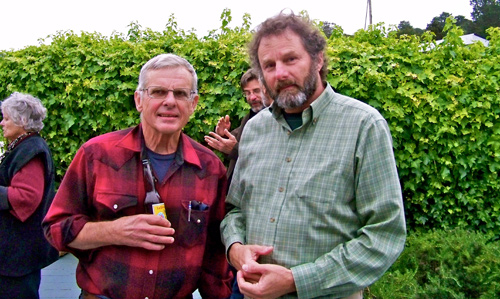 George Clyde of Marshall (left), a former programmer at KWMR radio, swaps stories with historian Dewey Livingston of Inverness.
George Clyde of Marshall (left), a former programmer at KWMR radio, swaps stories with historian Dewey Livingston of Inverness.

